Insects: Arthropod Gall Makers - Cell Pirates
By Lee Townsend
Gall makers arrive silently like ancient buccaneers but without eye patches or parrots on their shoulders. Just as surely though, they commandeer their prizes efficiently and quickly set them to do their bidding with eye-catching results. Gall makers include a variety of mostly wasps, some flies, and a few aphids and mites. Instead of taking their bounty to a hidden cove, the selected leaf bud or other site on a tree is hijacked chemically to produce a casing of plant tissue that shelters and nurtures the gall maker’s developing offspring. Oaks are the target of well over half of these interesting creatures. Galls may occur on leaves, bark, flowers, buds, or roots. With the exception of some twig and stem galls, most growths do not harm healthy trees.
Oak apple gall is one-half to 2-inch diameter round growth on a petiole or midrib of red, black, scarlet oak leaves. A single wasp larva develops in a hard seed-like cell in the center containing the wasp larva. The mature gall will develop a paper thin brown covering just before the new wasp emerges.
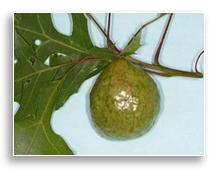
Roly-poly or succulent oak gall encloses small, "seed-like" ball within the hollow grape-like outer shell that houses the developing wasp. It is found on pin oak.
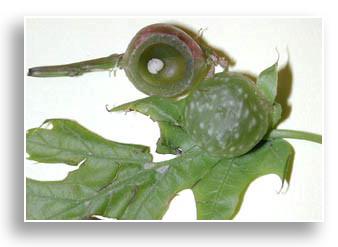
Wool sower gall, also caused by a tiny wasp, appears on white oak in early summer and resemble toasted marshmallows when “ripe”. Inside are small, hairy, seed-like structures, each containing a developing wasp.
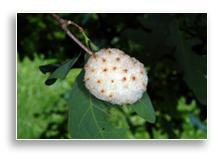
Woolly oak leaf galls lie along the midrib on the underside of the leaf. The balls, each with a hard portion containing a developing wasp, will detach from the leaf and are dispersed by the wind.
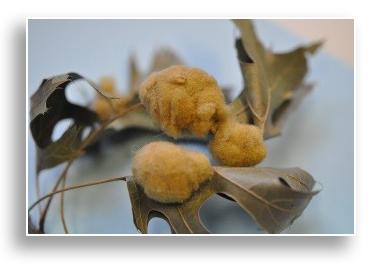
The gnarled oak leaf gall produces a twisted mass of thickened pin oak leaf tissue. The gall has patches of white hair-like growth and is full of small maggots. The gall maker is a small gnat.
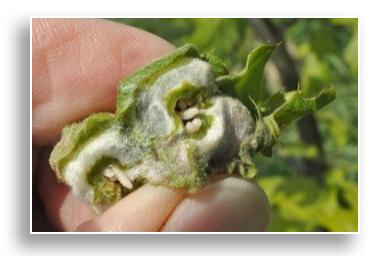
The hedgehog gall lies along the leaf midrib of white oak. The galls, which turn red as they ripen, contain three to five cells encasing developing wasp larvae.
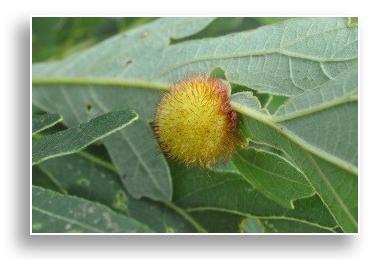
Oak spangle galls appear on the undersides of leaves in mid-summer. Wasp larvae remain in the galls over the winter and emerge during the following spring. More than 100 galls may be found on a single leaf.
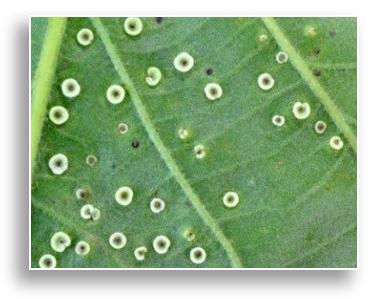
Marginal fold galls are caused by the maggots of small gnats. The galls are not a problem but small predator mites that feed on the maggots can cause intense itching if they drop on people when leaving the tree in the fall.
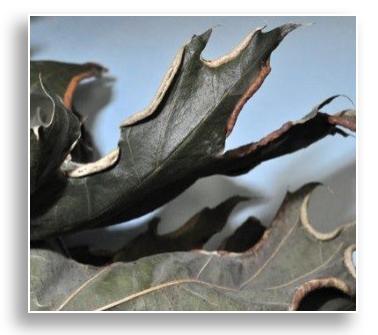
Two twig and stem galls can be serious problems. Gouty oak galls and horned oak galls are solid, woody masses that can girdle branches or make them droop from the sheer weight of the heavy growths. They can grow to more than 2 inches in diameter. Pin oak and willow oak are primary hosts. These galls have a long and complex development that takes almost 3 years. The first stage is a blister-like leaf gall that occurs along larger leaf veins. The second stage is a knotty twig gall that develops in mid-summer and matures more than a year later. Gouty oak twig galls are smooth; horned oak galls develop spike-like projections when the wasps are ready to emerge. Unfortunately, there are not effective management strategies for them. Dieback occurs as these growths girdle branches. More information is available at http://www2.ca.uky.edu/entomology/entfacts/ef457.asp
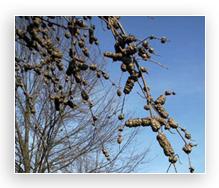
Photography
- Oak apple gall (L. Townsend)
- Roly-poly or succulent oak gall (L. Townsend)
- Wool sower gall (L. Townsend)
- Woolly oak leaf galls (L. Townsend)
- Gnarled oak leaf gall (L. Townsend)
- Hedgehog gall (L. Townsend)
- Oak spangle galls (L. Townsend)
- Marginal fold galls (L. Townsend)
- Gouty oak galls (L. Townsend)
About the Author
Dr. Lee Townsend is an Extension Entomologist in the University of Kentucky College of Agriculture. Email @ Lee.Townsend@uky.edu
